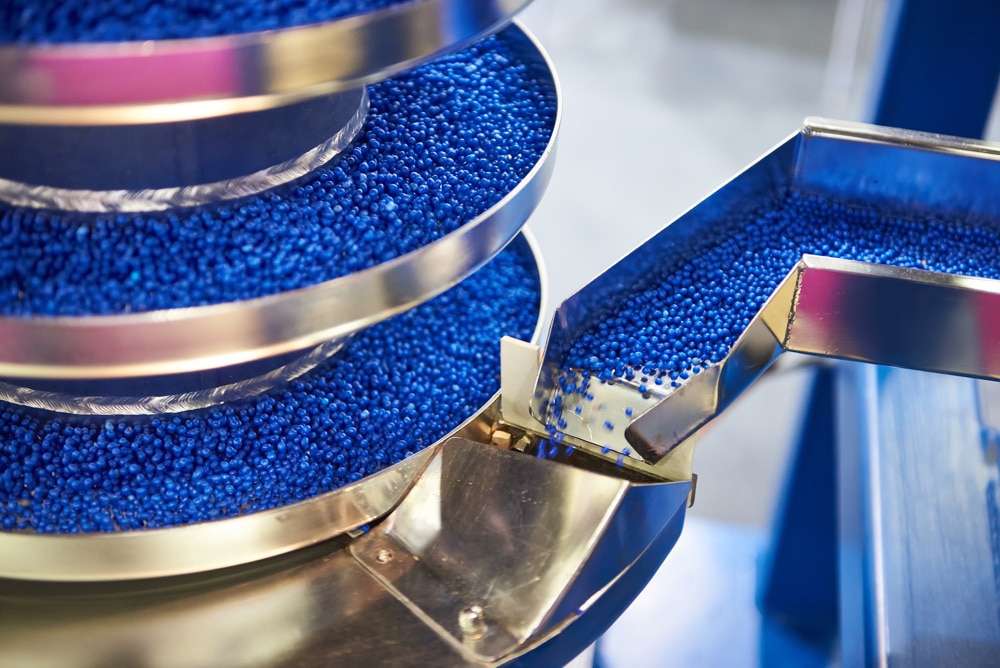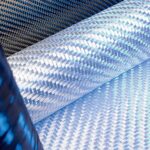Injection moulding (United States Injection Molding) is a manufacturing technique for making parts from thermoplastic material. Molten plastic is injected at high pressure into a mold, which is the inverse of the desired shape. The mold is made by a moldmaker (or toolmaker) from metal, usually either steel or aluminium, and precision-machined to form the features of the desired part. Injection moulding is very widely used for manufacturing a variety of parts, from the smallest component to entire body panels of cars. It is the most common method of production, with some commonly made items including bottle caps and outdoor furniture. The most commonly used thermoplastic materials are polystyrene (low-cost, lacking the strength and longevity of other materials), ABS or acrylonitrile butadiene styrene (a co-polymer or mixture of compounds used for everything from Lego parts to electronics housings), nylon (chemically resistant, heat-resistant, tough and flexible – used for combs), polypropylene (tough and flexible – used for containers), polyethylene, and polyvinyl chloride or PVC (more common in extrusions as used for pipes, window frames, or as the insulation on wiring where it is rendered flexible by
the inclusion of a high proportion of plasticiser).
Compression molding is a method of molding in which the molding material, generally preheated, is first placed in an open, heated mold cavity. The mold is closed with a top force or plug member, pressure is applied to force the material into contact with all mold areas, and heat and pressure are maintained until the molding material has cured. The process employs thermosetting resins in a partially cured stage, either in the form of granules, putty-like masses, or preforms. Compression molding is a high-volume, high-pressure method suitable for molding complex, high-strength fiberglass reinforcements. Advanced composite thermoplastics can also be compression molded with unidirectional tapes, woven fabrics, randomly orientated fiber mat or chopped strand. The advantage of compression molding is its ability to mold large, fairly intricate parts. Compression molding produces fewer knit lines and less fiber-length degradation
than injection molding.
Extrusion moulding is a manufacturing process used to make pipes, hoses, drinking straws, curtain tracks, rods, and fibres.The machine used to extrude materials is very similar to an injection moulding machine. A motor turns a screw which feeds granules of plastic through a heater. The granules melt into a liquid which is forced through a die, forming a long ‘tube like’ shape. The shape of the die determines the shape of the tube. The extrusion is then cooled and forms a solid shape. The tube may be printed upon, and cut at equal intervals. The pieces may be rolled for storage or packed together. Shapes that can result from extrusion include T-sections, U-sections, square sections, I-sections, L-sections and circular sections. One of the most famous
products of extrusion moulding is the fiber optic.
Blow molding or blow moulding is a manufacturing process by which hollow plastic parts are formed. In general, there are three main types of blow molding; Extrusion Blow Molding,
Injection Blow Molding, and Stretch Blow Molding.
Extrusion blow molding In Extrusion Blow Molding (EBM), plastic is melted and extruded into a hollow tube (a parison). This parison is then captured by closing it into a cooled metal mold. Air is then blown into the parison, inflating it into the shape of the hollow bottle, container or
part. After the plastic has cooled sufficiently, the mold is opened and the part is ejected.
Injection blow molding The process of Injection Blow Molding (IBM) is used for the production of hollow glass and plastic objects in large quantities. In the IBM process, the polymer is injection molded onto a core pin; then the core pin is rotated to a blow molding station to be inflated and cooled. This is the least-used of the three blow molding processes, and is typically used to make small medical and single serve bottles. The process is divided into three steps:
injection, blowing and ejection.
The injection blow molding machine is based on an extruder barrel and screw assembly which melts the polymer. The molten polymer is fed into a manifold where it is injected through nozzles into a hollow, heated preform mould. The preform mold forms the external shape and is clamped around a mandrel (the core rod) which forms the internal shape of the preform. The preform consists of a fully formed bottle/jar neck with a thick tube of polymer attached, which
will form the body.
The preform mold opens and the core rod is rotated and clamped into the hollow, chilled blow mold. The core rod opens and allows compressed air into the preform, which inflates it to the
finished article shape.
After a cooling period the blow mold opens and the core rod is rotated to the ejection position. The finished article is stripped off the core rod and leak-tested prior to packing. The preform and blow mold can have many cavities, typically three to sixteen depending on the article size and the required output. There are three sets of core rods, which allow concurrent preform injection,
blow molding and ejection.
Another application of injection blow molding is in the production of soft elastic gelatin capsules for pharmaceutical applications. Two strips of gelatin are pressed together in a rotary die which cuts out the desired shape of capsule while the fill liquid is injected. Afterwards, they are cooled
and dried to yield a firm, strong capsule.
Stretch blow molding In the Stretch Blow Molding (SBM) process, the plastic is first molded into a “preform” using the Injection Molded Process. These preforms are produced with the necks of the bottles, including threads (the “finish”) on one end. These preforms are packaged, and fed later (after cooling) into an EBM blow molding machine. In the SBM process, the preforms are heated (typically using infrared heaters) above their glass transition temperature, then blown using high pressure air into bottles using metal blow molds. Usually the preform is stretched with a core rod as part of the process. The stretching of some polymers, such as PET (Polyethylene Terephthalate) results in strain hardening of the resin, allowing the bottles to resist
deforming under the pressures formed by carbonated beverages, which typically approach 60 psi.
The main applications are bottles, jars and other containers. The Injection blow molding process produces bottles of superior visual and dimensional quality compared to extrusion blow molding. The process is ideal for both narrow and wide-mouthed containers and produces them fully finished with no flash. A sign of injection blow molding is the seam where the two halves of the
mold meet.
This picture shows what happens inside the blow mold. The preform is first stretched mechanically with a stretch rod. As the rod travels down low-pressure air of 5 to 25 bar (70 to
350 psi) is introduced blowing a ‘bubble’. Once the stretch rod is fully extended, high-pressure air of up to 40 bar (580 psi) blows the expanded bubble into the shape of the blow mold.


